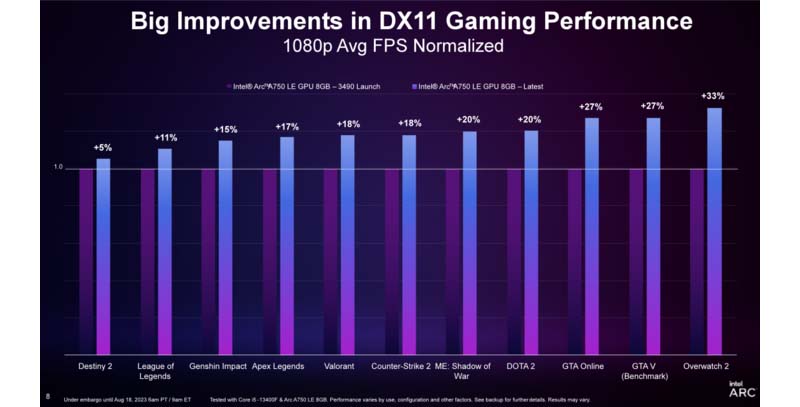Intel was a showcase of their commitment to driving the future of graphics and computing, shared significant performance updates for their Xe graphics on DX11. With the release of the latest Game On driver, Intel Xe graphics exhibited a substantial 19% improvement in frame rates. Additionally, an average of around 20% improvement in 99th percentile frame rate smoothness was observed during a series of DX11 games. These improvements mark a significant step forward in Intel’s quest to redefine gaming performance.
Intel PresentMon Beta Tool
Intel didn’t stop at graphics performance enhancements. They also introduced the new Intel PresentMon Beta tool, which is set to revolutionize the way gamers analyze their systems’ performance. This tool offers features like Overlay, enabling real-time display of performance data on the screen while playing games. It allows players to monitor GPU voltage, temperature, and other metrics, providing a real-time analysis of a wealth of information.
One of the standout features of the PresentMon Beta is the GPU Busy metric. This feature allows users to see how much time the GPU spends rendering versus waiting, providing insights into whether the game is CPU or GPU bound. This level of transparency and control is a game-changer for gamers looking to optimize their systems for optimal performance.
AIGC Advancements
Intel’s advancements in the Artificial Intelligence in Graphics and Computing (AIGC) field were also a focal point during the briefing. The PC remains the primary device for these applications, including ChatGPT, MidJourney, such as Microsoft Copilot based on large models, PC with its larger screens, more efficient input methods, and superior chip performance, continues to hold an edge over other devices like smartphones and tablets.
Previously, running AIGC applications on PCs often required high-performance gaming laptops, which excluded thinner and lighter laptops. However, Intel’s latest developments suggest that thin and light laptops based on Intel processors can now effectively handle large models and Stable Diffusion applications.
Thanks to Intel’s backend solution based on OpenVINO PyTorch, community-developed models can run efficiently on Intel client processors, integrated graphics, discrete graphics, and dedicated AI engines. This optimization opens up a world of possibilities for users, from text-to-image generation to image-to-image generation, even local image restoration.
The Power of 13th Generation Intel Core Processors
The advancements in the 13th generation Intel Core processors are worth noting. Laptops featuring the 14-core, 20-thread i7-13700H processor with a TDP of 45W and the integrated Intel Iris Xe Graphics (96EU) are making waves in terms of core count, performance, power efficiency, and graphics performance.
Intel Iris Xe Graphics offers significant improvements in basic specifications, with FP16 and FP32 floating-point performance increasing by up to 84%. It also introduces INT8 integer compute capability, enhancing its AI graphics computing capabilities. This is a crucial factor enabling Intel’s thin and light laptops to support Stable Diffusion effectively.
The Future of Thin and Light Laptops
In the past, fitting Intel processors with a TDP of around 45W into thin and light laptops was a challenge. However, with the 13th generation Intel Core processors, laptops weighing around 1.4kg can comfortably accommodate the 14-core, 20-thread i7-13700H processor and even higher-performing i7-13900H processors, development means that running Stable Diffusion and generating images quickly is no longer exclusive to high-performance gaming laptops but can also be achieved on thin and light laptops.
With the help of the 13th generation Intel Core processors’ XPU acceleration, low-bit quantization, and other software optimizations, large language models with up to 16 billion parameters can run on personal computers with 16GB or more of memory capacity using the BigDL-LLM framework, support PCs that can quickly integrate emerging models, including LLAMA/LLAMA2, ChatGLM/ChatGLM2 etc.
During the technical briefing, Intel demonstrated the performance of running large models on a device equipped with the Core i7-13700H processor. For example, ChatGLM-6b achieved a first token generation latency of 241.7ms and an average generation rate of 55.63ms/token for subsequent tokens.
Intel Xe Graphics Performance Updates
Intel held a technical briefing to unveil exciting updates on several fronts. One of the highlights was the substantial performance boost in the Intel Xe graphics on DX11 games. With the release of the latest Game On driver, Intel Xe graphics have seen a 19% improvement in frame rates. Furthermore, an average of around 20% improvement has been noted in the 99th percentile frame rate smoothness across multiple DX11 games. These advancements are a testament to Intel’s commitment to pushing the envelope in graphics performance.

13th Gen Intel Core CPU
13 gen CPU have played a crucial role in these advancements, Brand an Upgrade Core Ultra i9, i7, and i5, upgraded Core processors are split into two categories, the Ultra and non-Ultra. The Ultra brand is reserved for the new Meteor Lake architecture, such as the Core i7 Ultra 1003H, Core i7 Ultra 1002H, and Core i5 Ultra 1003H. Laptops featuring the 14-core, 20-thread i7-13700H processor with a TDP of 45W and the integrated Intel Iris Xe Graphics (96EU) have demonstrated notable enhancements in core count, performance, power efficiency, and graphics performance.
Intel Core Ultra i7 Chips Hit Blazing 5GHz+ Speeds for single-core speeds
Compared to the previous Iris Plus graphics with a maximum of 64 execution units (EU), Intel Iris Xe Graphics offers significant improvements in basic specifications. It includes an increase of up to 84% in FP16 and FP32 floating-point performance and the introduction of INT8 integer compute capability, which bolsters its AI graphics computing capabilities.